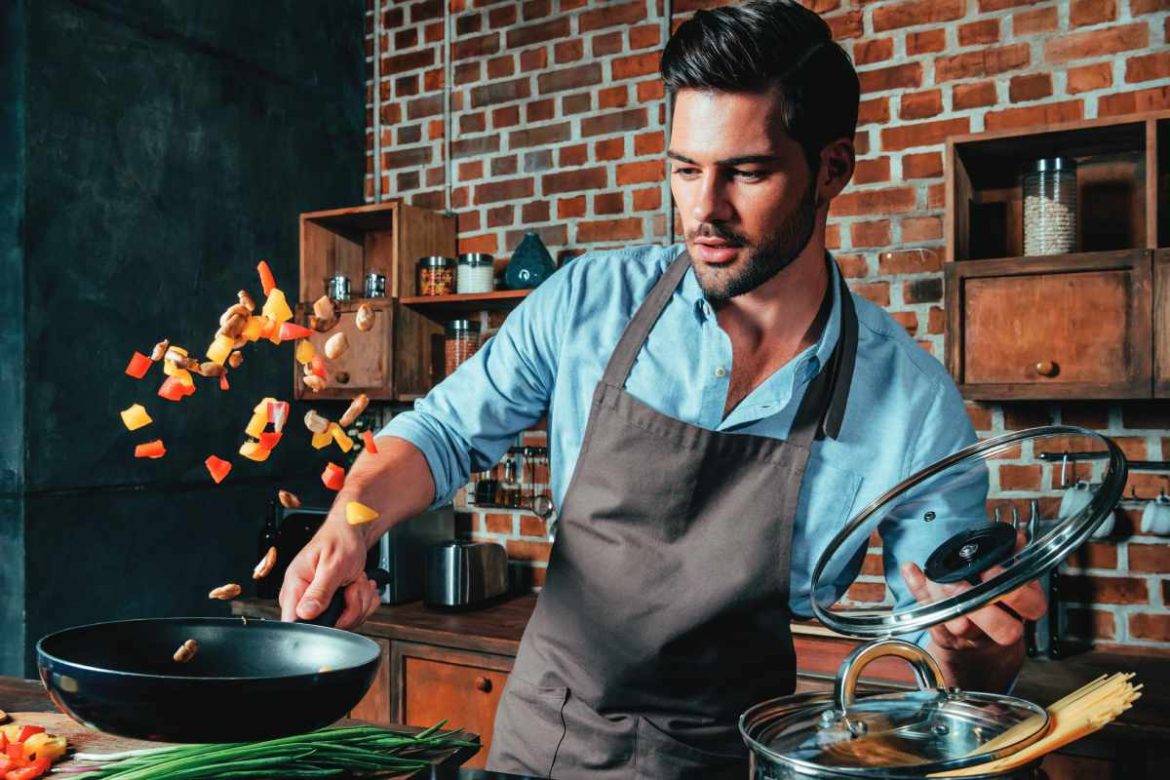People are discovering the flavorful dimensions of cannabis, while more and more chefs are mixing ganja with gastronomy and playing with the tastes, smells and, of course, the effects.
Well before any notion of actual legal weed took root, there were brownies. “Magic brownies” seem to be where eating marijuana all began. Cue visions of hippies passing infused treats around at parties, hoping the dosage would deliver perfect euphoria, rather than a bad high, or no high at all. In 2022, however, pot brownies have been replaced by literally hundreds, maybe thousands, of other types of edibles and beverages.
There are gummies, chocolates, mints, cookies, teas, seltzers, cooking oils, and so many more, it’s like trying to count the number of trees in a forest. Not to mention marijuana flower to smoke, plus hash, vape oils, topical creams, lubes, tinctures, and concentrates like wax and diamonds.
And let’s not overlook the countless varieties of cannabis, which includes both hemp and marijuana. There’s the already-ubiquitous hemp-derived CBD, with its non-intoxicating wellness benefits; high-making marijuana with its potent Delta-9 THC; and scores of other cannabinoids and strains that keep on coming.
Beyond the manufactured products seen on dispensary shelves, consumers are discovering even more flavorful dimensions of ganja. Meanwhile, more and more chefs are mixing cannabis with gastronomy, playing with tastes, smells and, of course, the effects.
CANNABIS CUISINE TRENDING
Maybe you’ve caught an episode of Netflix’s Cooked with Cannabis, or Vice TV’s Bong Appetit. These and other niche culinary shows share a peek at the range and nuances of cannabis in cooking. The recipes and cannabis add-ons are intriguing, but weed-cooking shows tend to seem gimmicky.
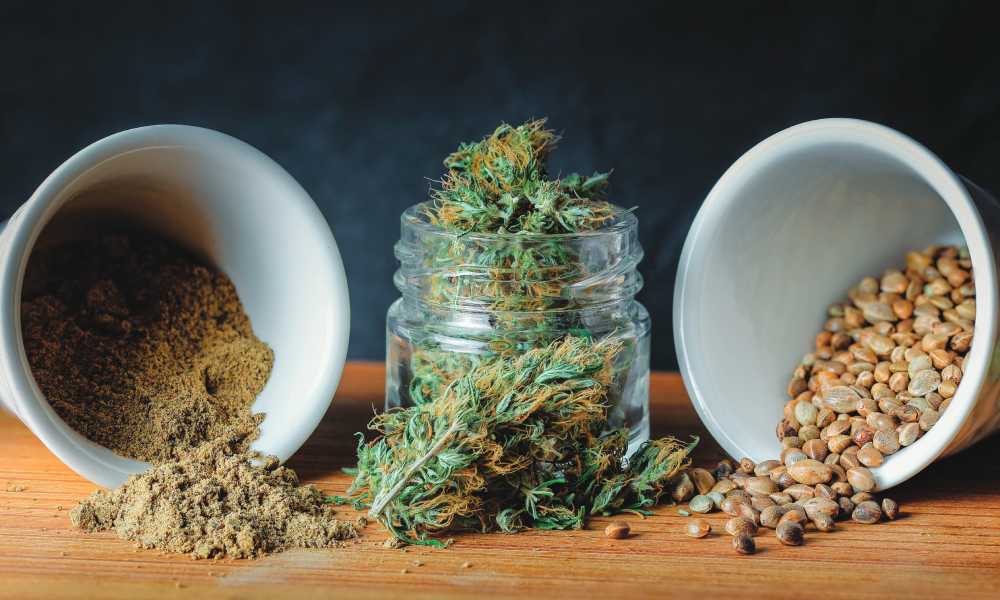
Cannabis Flour, Flowers, and Seeds (Photo by Omar Tomaino)
Chefs frequently prepare dishes without considering the array of cannabinoids and their psychoactive impact. They’ll add in flower strains according to flavor profile not potency, sometimes overlooking the effect of heat on cannabis. In other words, you may see a chef toss in ground Lemon Haze leaf like an afterthought for a citrus-based sauce, and cook off half of its THC.
On the tasting side, TV hosts and “judges” often embody stoner clichés, giddily awaiting naughty noshes and getting goofier, and less discerning, by the forkful. For sure it can be entertaining, but refined culinary programming it is not.
Portland-based Chef Liv Vasquez won her episode of Cooked with Cannabis, but noted that Netflix producers and participants were “not really thinking a ton about the science behind the effect and absorption rate, which was disappointing for me because I was excited to hopefully share other tips and tricks with people,” she says. “It became pretty apparent to me by the time I showed up on set that they really just wanted to show off product.”
A chef and restaurateur since age 18, Vasquez spent years educating herself in cannabis science, learning about cannabinoids, strains, forms, and their intersections with food and the human body. She’s collaborated with fellow chefs and other partners, including tourism companies, to feed curious cannabis fans in legal-THC states like Oregon, and elsewhere. Often her work starts with helping people overcome past bad edible experiences, which was a driving force behind her ebook Smart Infusion: A Basic Guide to Understanding Edibles.
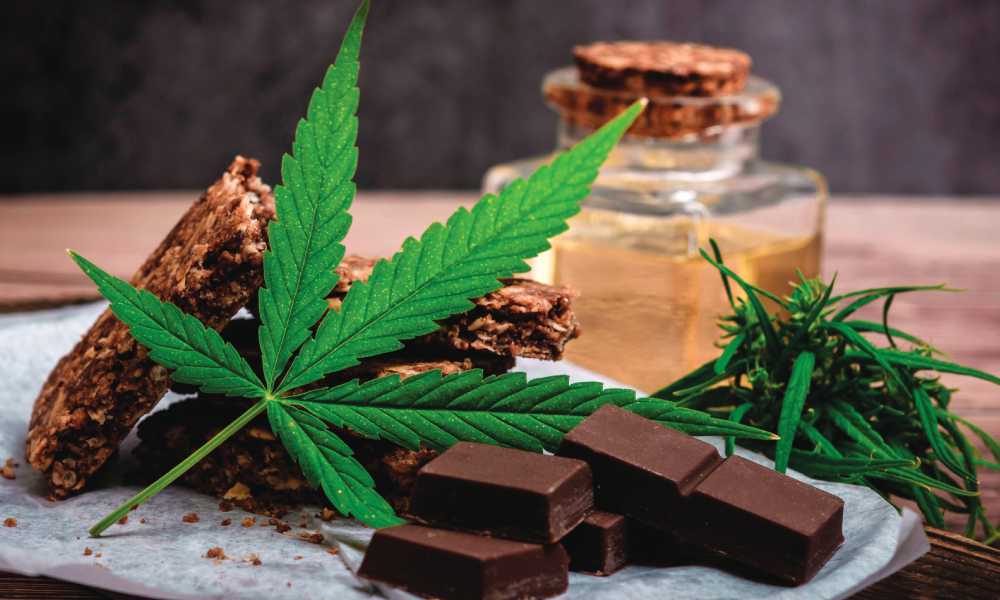

Cannabis Treats (Photo by Aedka Studio)
Beyond the manufactured products seen on dispensary shelves, consumers are discovering more flavorful dimensions of ganja, while more and more chefs are mixing cannabis with gastronomy, playing with tastes, smells and, of course, the effects.
The book examines different forms of infusion and extraction in cooking, and why, for example, a sugary baked treat may have a different effect using oil versus butter. Vasquez applies her more conscientious techniques when hosting curated dining experiences, saying, “I don’t believe in making big batches. I don’t host big events, because I don’t want anyone to feel like if they’re having a bad time, or if they’re feeling over-served, that they can’t have any help.”
BUD BITES BASICS
Dosage is a vital part of the cannabis experience, which is why so many people have tried a pot brownie or other edible, had a bad time, and sworn them off forever. Usually that’s due to the potency of Delta-9 THC (tetrahydrocannabinol), aka regular high-making marijuana, which can cause paranoia or nausea if over-consumed.
Meanwhile, CBD (cannabidiol), CBN (cannabinol), CBG (cannabigerol), and other hemp-derived cannabinoids, which scientists are still discovering, have minimal psychoactive effects. They’re commonly used for health and wellness benefits such as reducing inflammation, relieving pain and anxiety, improving sleep, and supporting the all-important endocannabinoid system, which regulates other systems in the body. Those cannabinoids also serve up vitamins and minerals beyond basic phytonutrient perks.
Newer to the weed world is Delta-8 THC, a far milder high-making compound said to have about 10 percent of a Delta-9-THC high; some consumers compare it to having a glass of wine.
With so many considerations at stake, most cannabis-savvy chefs will curate a menu based on a consumer’s intentions and weed experience. The key is starting with a low dose, whether it’s CBD or THC. And just like eating an infused gummy or other premade edible, pot newcomers are wise to start with five or 10 milligrams of cannabis, and wait at least 90 minutes before eating more.
Another hot tip is to start a cannabis-paired meal with CBD or low dose THC dishes, to promote gentle euphoria without peaking too early. Too much weed too soon also may stimulate your appetite, which could lead to overconsumption.
“If you’re going to experiment with edibles, it’s important to see what your individual threshold is, and what you want it for, like pain relief or better sleep,” says chef and nutritionist Melissa Gellert. “Do experiment, instead of just jumping in. And once you’re combining cannabis with different recipes, the math becomes much more important. Learn how many milligrams are in a bottle [of infused oil], are in a dropperful, are in a single drop.”
Compared with alcohol, most people are simply inexperienced with cannabis, says Vasquez. “Alcohol has been out of prohibition for so long that people have been able to explore their parameters, but there’s this stigma when it comes to exploring your parameters around cannabis edibles,” she says. “Like when you turn 21 and you go out drinking, you’re drinking all the dumb stuff like Long Island iced teas. Then once you grow up, and your digestion changes, your body’s absorption of that alcohol changes, and you figure out what works for you. [You may know], ‘I can’t drink rum because I’ll have a terrible hangover.’
“It’s the same with edibles, ‘Oh I can’t have something that’s infused with distillate, because it gives me a headache.’ Those kinds of things you have to learn on your own, because everybody’s digestion is unique,” says Vasquez.
Unlike alcohol, cannabis absorption has more to do with your age than your height or weight, says Vasquez. “I’ve had so many men specifically come to me and say, ‘Well I’m a big guy, I can take a lot.’ But you can’t use that as a measuring tool.”
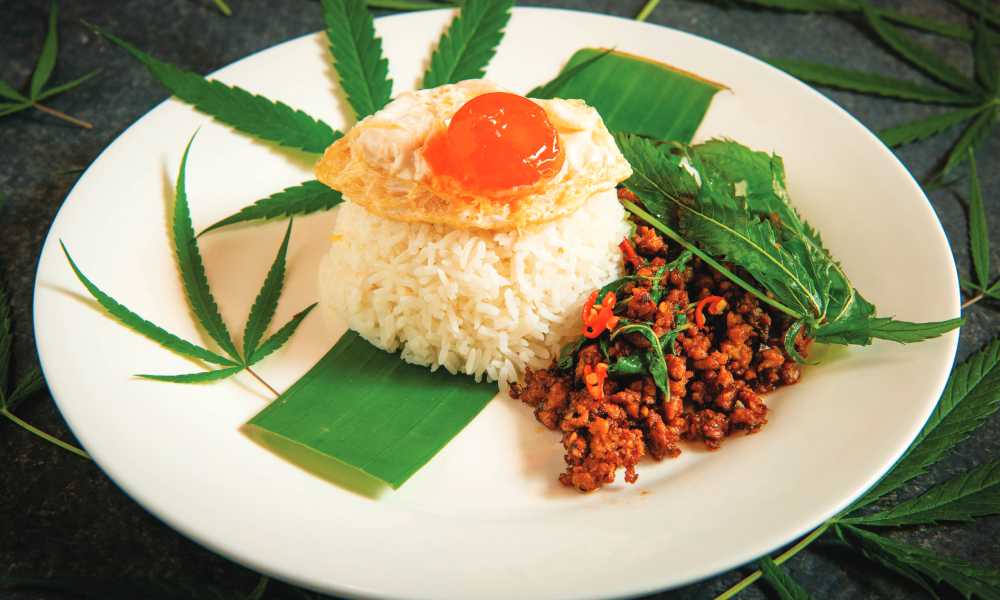

Stir Fried Pork with Fried Egg on Rice (Photo by Atit Siriprarob)
PAIRING POT FLAVORS
Cannabis is an expensive ingredient, so most chefs will point out that it’s used for effects more than flavor. To maximize those effects without wasting any precious cannabinoids, chefs like Gellert and Vasquez often decarboxylate cannabis themselves, which means they use a special heating process to release and activate the THC. The home-decarb method lets them make small batches of infused oil or butter, and harness certain strains’ flavors and aromas.
Those tastes and scents are the gift of terpenes, the natural aromatic flavonoids of plants. Terpenes are especially rich in cannabis plants, giving strains unique aromatic profiles like pine, citrus, and herbs like thyme and sage. They also come with their own effects, so a strain with the terpene myrcene, for example, may make you feel relaxed or even sleepy; while lemony limonene might perk up your mood.
There’s a growing number of cannabis-cooking products out in the world too, like EVO3’s Greek-origin extra-virgin organic CBD olive oil, and other small-batch oils made with THC. The bonus of such craft products is both in flavor and in knowing precise milligrams in each container.
If you’re planning to try an infused oil on your own, Vasquez’s best advice is to never heat it up and risk cooking off the cannabinoids. “Use it as a finishing oil,” she says. “You want to drizzle it on like truffle oil. If you were to put a truffle or sesame oil in a hot pan while it’s cooking, it’s losing the flavor, and with cannabis oil, the effects.”
For Angie Willoughby, who goes by “The Green Baker,” layering flavors into her cannabis dishes usually leads to a more luscious tasting experience. “Having many different [infusion forms] is so important to me, from sugar to honey to olive oils and butter, and even things like cream. Gone are the days of just grassy tasting pot brownies or questionably dosed chocolate-chip cookies.”
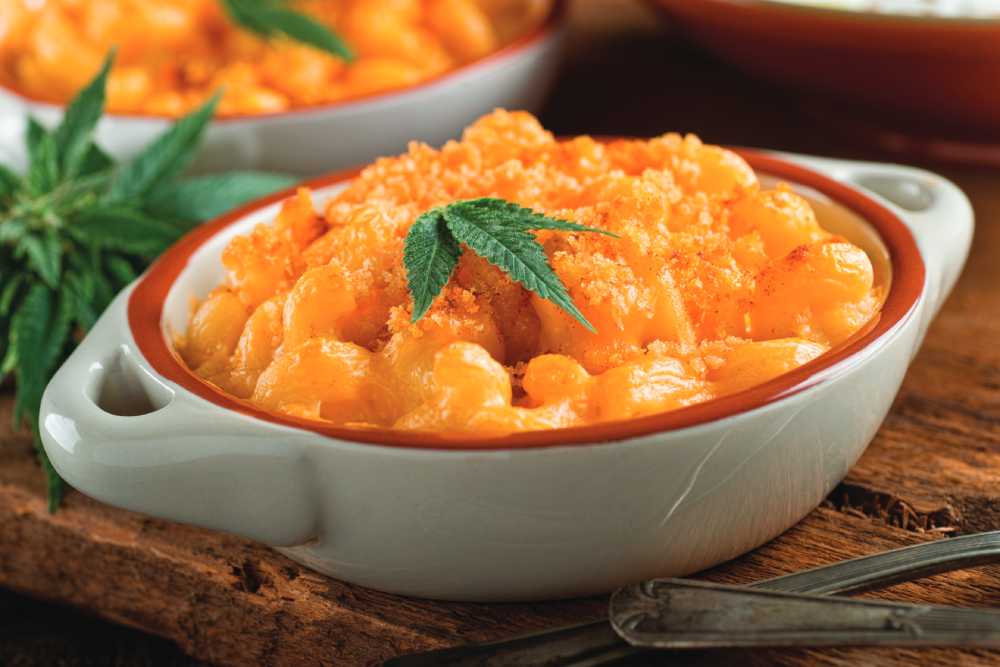

Mac and Cheese with Cannabis (Photo by Foodio)
Natural herbaceous flavors of cannabis pair better with savory dishes like pasta and salads, Vasquez explains, instead of sweet treats that may cover up the flavor with sugar. One simple recipe may be the Italian classic spaghetti aglio e olio (garlic and oil), drizzling in a tiny amount of THC- or CBD-infused olive oil.
For Gellert, using strains with pine and herbal flavors are perfect to drizzle into or over a rosemary focaccia. On the other hand, she says, that Lemon Haze strain may be the perfect flavonoid for a simple baked lemon bar.
THE GREEN FUTURE
Remarkably, marijuana is federally illegal and listed as a Schedule-1 substance, aligning the plant with heroin and Quaaludes, and defining it as less medically useful than cocaine, methamphetamine, and fentanyl.
And yet, today, adult-use recreational marijuana is legal in 18 U.S. states, along with the District of Columbia and three U.S. territories; and medical marijuana is legal in 37 states. Meanwhile, hemp (which encompasses CBD and Delta-8 THC) has been legal nationally since 2014.
It’s impossible to know what fate holds for legal cannabis in America, but with still more states voting on its legality this fall, one can only predict its continued acceptance and popularity.
Culinary cannabis, however, remains a new frontier even for the most seasoned consumers. Consider the method of building a perfect cocktail, one that balances a liquor with other ingredients, all blended and poured in a particular way. Mingling food and weed are the same. It’s about learning how to pair tastes, combine flavors, and phase intake for the most euphoric, delicious experience. No matter what the future holds for cannabis in America, you can bet it will be tasty.
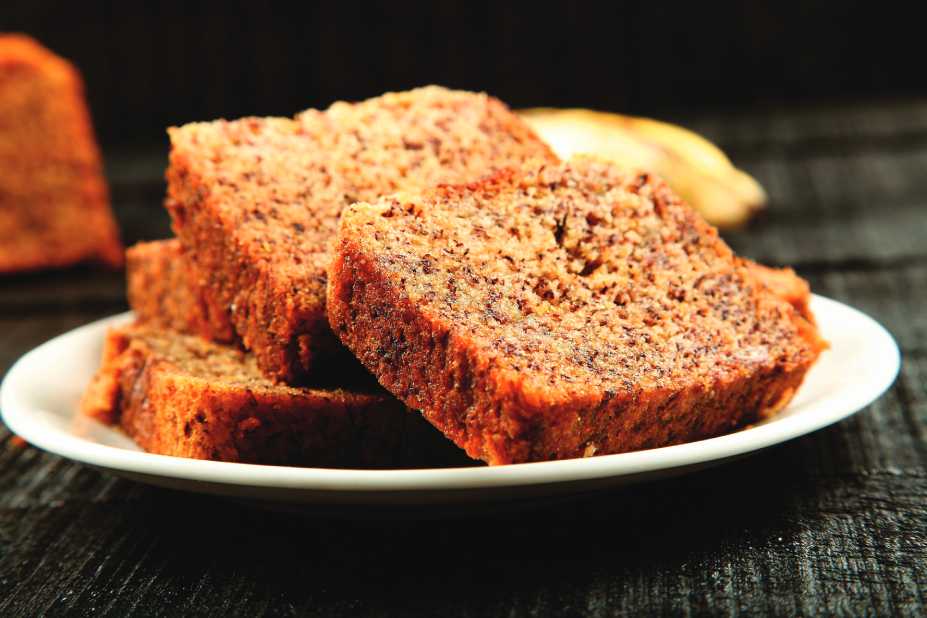

Banana Bread (Photo by Sam Thomas)
Grain-Free THC-Infused Banana Bread
Recipe adapted by Melissa Gellert from SmallFootprintFamily.com
Makes 8-10 servings
Ingredients:
3/4 teaspoon baking soda
1/2 teaspoon sea salt
3/4 cup almond flour
1/4 cup coconut flour
2 tablespoons cannabis-infused virgin coconut oil (100 mgs THC)*
3 pasture-raised eggs room temperature
2 bananas very ripe, about 1 cup of mashed banana
1/4 cup maple syrup, raw honey, or date paste (made by soaking 8-10 medjool dates with a
little warm water till soft, then blending)
1/2 cup allergen-free chocolate chips (optional)
Instructions:
Preheat the oven to 350° F.
Line a loaf pan with parchment paper. Using a whisk or fork, mix all the dry ingredients
together. If your coconut oil is solid, gently warm it over very low heat in a saucepan. Do not
microwave it, as this may destroy the cannabinoids.
In a separate bowl, mix all the wet ingredients together, and then mix them into the dry ingredients. If needed, you can use a stick blender or mixer to ensure the batter is well blended. Add the batter to a baking dish. Bake for 45-50 minutes, or until well browned and a knife inserted in the middle of the bread comes out clean.
Slice into 10 servings. Each serving contains about 10 mgs THC.
*1 fluid ounce oil (2 tablespoons):1 g cannabis (about 100 mgs of THC)
You May Also Enjoy
Cannabis Tourism: More Than A Rocky Mountain High


